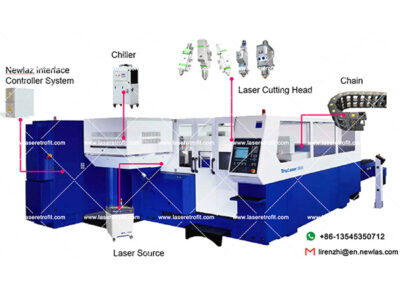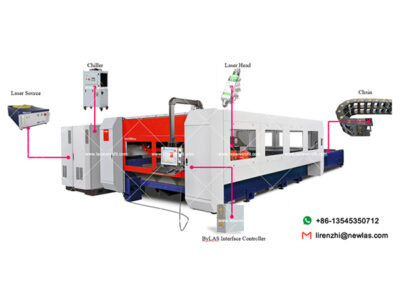There are many factors that affect the laser cutting quality, but this does not mean that it is difficult to obtain high laser cutting quality. Users can analyze which factors may affect the cutting quality according to the processing effect to adjust the parameters. Next, we will share the common laser cutting problems and solutions so that you can solve your laser cutting quality problems in time.
Stainless steel, galvanized steel, aluminum & brass laser cutting problems and solutions
| Problems | Possible Reasons | Solutions |
| There are small drip-shaped regular burrs on the cutting seam | 1. The laser focus position is too low. 2. The cutting speed is too high. 3. The laser power is too low. | 1. Raise the laser focus position. 2. Reduce the cutting speed. 3. Increase the laser power. |
| There are long irregular burrs on both sides of the cutting seam, and there is discoloration on the metal surface | 1. The cutting speed is too slow. 2. The laser focus position is too high. 3. The air pressure is too low. 4. The material is too hot. 5. The transmission system is not stable. | 1. Increase the cutting speed. 2. Lower the laser focus position. 3. Increase the air pressure. 4. Cool the material. 5. Check and adjust the transmission system. |
| There are long irregular burrs on one side of the cutting seam | 1. The nozzle is not aligned. 2. The laser focus position is too high. 3. The air pressure is too low. 4. The cutting speed is too slow. 5. The center position of the laser focusing lens is offset. 6. The nozzle is partially blocked or damaged. 7. The lens is polluted or damaged. | 1. Check and adjust the nozzle. 2. Lower the laser focus position. 3. Increase the air pressure. 4. Increase the cutting speed. 5. Check and adjust the center position of the laser focusing lens. 6. Clean or replace the nozzle. 7. Clean or replace the lens. |
| The molten material is discharged from the upper side of the material | 1. The laser power is too low. 2. The cutting speed is too high. 3. The air pressure is too high. | 1. Increase the laser power. 2. Reduce the cutting speed. 3. Reduce the air pressure. Note: Be sure to check if the laser focusing lens is damaged or not, and replace it with a new one if needed. |
| The cutting edge becomes yellow | 1. The auxiliary gas is not pure. 2. There are some oxygen gases or air in the air tube. | 1. Check the purity of nitrogen, use nitrogen gas with high purity. 2. Increase delay to clean the air tube. |
| The cutting seam is rough | 1. The nozzle is damaged. 2. The lens is polluted. | 1. Check or replace the nozzle. 2. Clean or replace the lens. |
Carbon steel laser cutting problems and solutions
| Problems | Possible Reasons | Solutions |
| When cutting a round shape, the finished workpiece is not round | 1. The center position of the lens is not correct. 2. The nozzle is blocked or damaged. 3. The laser path is not correct. | 1. Check and adjust the center position of the lens. 2. Check or replace the nozzle. 3. Check and adjust the laser path. |
| The finished workpiece has a gap at the cutting introduction position | 1. The piercing process is too long. 2. The heat is too high during the cutting. | 1. Shorten the piercing time. 2. Reduce the duty cycle and cool the material. |
| The traction line at the bottom is offset, and the bottom cutting slit is wider | 1. The cutting speed is too high. 2. The laser power is too low. 3. The air pressure is too low. 4. The laser focus position is too high. | 1. Reduce the cutting speed. 2. Increase the laser power. 3. Increase the air pressure. 4. Lower the laser focus position. |
| There are drip-shaped burrs that are similar to slag and are easy to remove | 1. The cutting speed is too high. 2. The air pressure is too low. 3. The laser focus position is too high. | 1. Reduce the cutting speed. 2. Increase the air pressure. 3. Lower the laser focus position. |
| The burrs are connected and can be removed as a whole piece | The laser focus position is too high. | Lower the laser focus position. |
| The burrs on the bottom of the cutting seam are hard to remove | 1. The cutting speed is too high. 2. The air pressure is too low. 3. The auxiliary gas is not pure. 4. The laser focus position is too high | 1. Reduce the cutting speed. 2. Increase the air pressure. 3. Use the auxiliary gas with higher purity. 4. Lower the laser focus position. |
| There are burrs on one side of the cutting seam | 1. The center position of the nozzle is not correct. 2. The nozzle is damaged. | 1. Check and adjust the center position of the nozzle. 2. Check or replace the nozzle. |
| The cutting edge is not precise | 1. The air pressure is too high. 2. The nozzle is damaged. 3. The diameter of the nozzle is too large. | 1. Reduce the air pressure. 2. Check or replace the nozzle. 3. Install a nozzle with proper diameter. |
| The texture on the cutting is very rough | 1. The laser focus position is too high. 2. The air pressure is too high. 3. The cutting speed is too slow. 4. The material is too hot. | 1. Lower the laser focus position. 2. Reduce the air pressure. 3. Increase the cutting speed. 4. Cool the material. |
| The molten material is discharged from the upper side of the material | 1. The laser power is too low. 2. The cutting speed is too high. | 1. Increase the laser power. 2. Reduce the cutting speed. Note: Be sure to check if the laser focusing lens is damaged. And replace with a new one if needed. |
| There are abnormal sparks during the cutting | 1. The thread at the connection between the nozzle and laser head is loose. 2. The nozzle is damaged. 3. The air pressure is too low. | 1. Tighten the thread. 2. Check or replace the nozzle. 3. Increase the air pressure. |
| The laser cannot cut through the material | 1. The laser power is too low. 2. The cutting speed is too high. 3. The laser focus position is too low. 4. The diameter of the nozzle does not match with the cutting thickness of the metal. | 1. Increase the laser power. 2. Reduce the cutting speed. 3. Raise the laser focus position. 4. Check and replace the nozzle. |
| The laser beam has breaks | 1. The cutting speed is too high. 2. The laser power is too low. 3. The laser focus position is too low. | 1. Reduce the cutting speed. 2. Increase the laser power. 3. Raise the laser focus position. |
Laser cutting quality is affected by many factors. First of all, improper parameter settings will affect the cutting result, such as laser power, cutting speed, air pressure, etc. In addition, sometimes there will be problems even if the parameters are set correctly. And this is usually because the gas purity is not enough, or the nozzle and lens are contaminated or damaged. Therefore, users need to check the nozzle before cutting, whether the laser head is working properly, and then set the appropriate parameters. Then, analyze the causes according to the specific laser cutting effect, and adjust parameters and check machine parts to achieve the best laser cutting quality.






